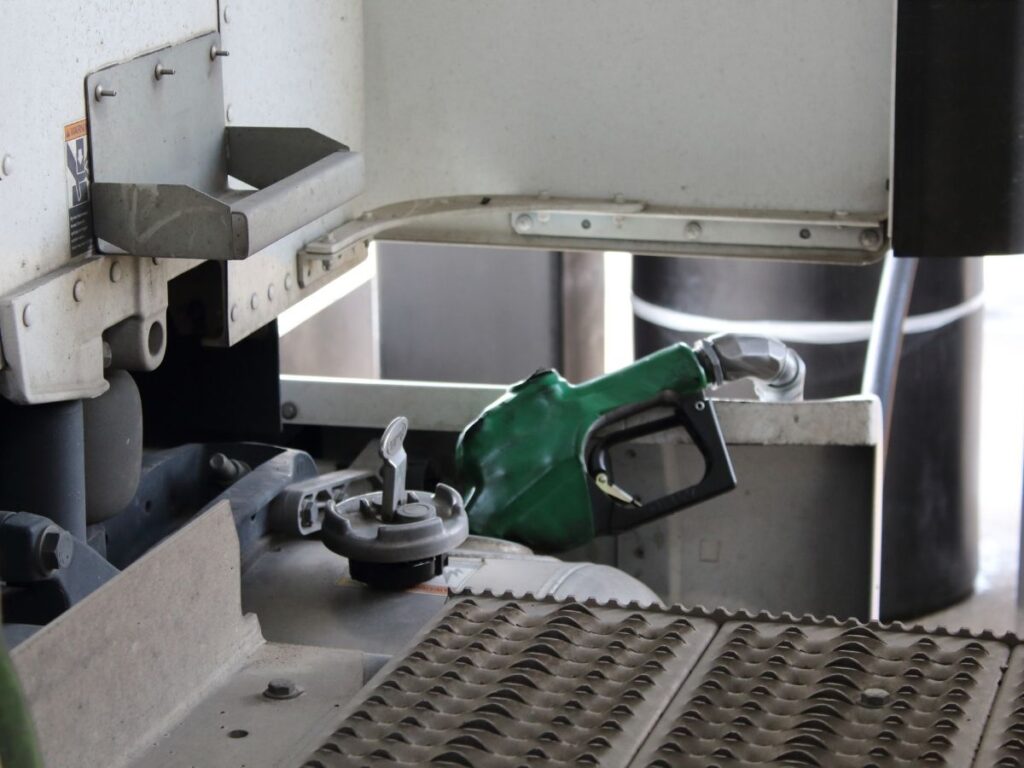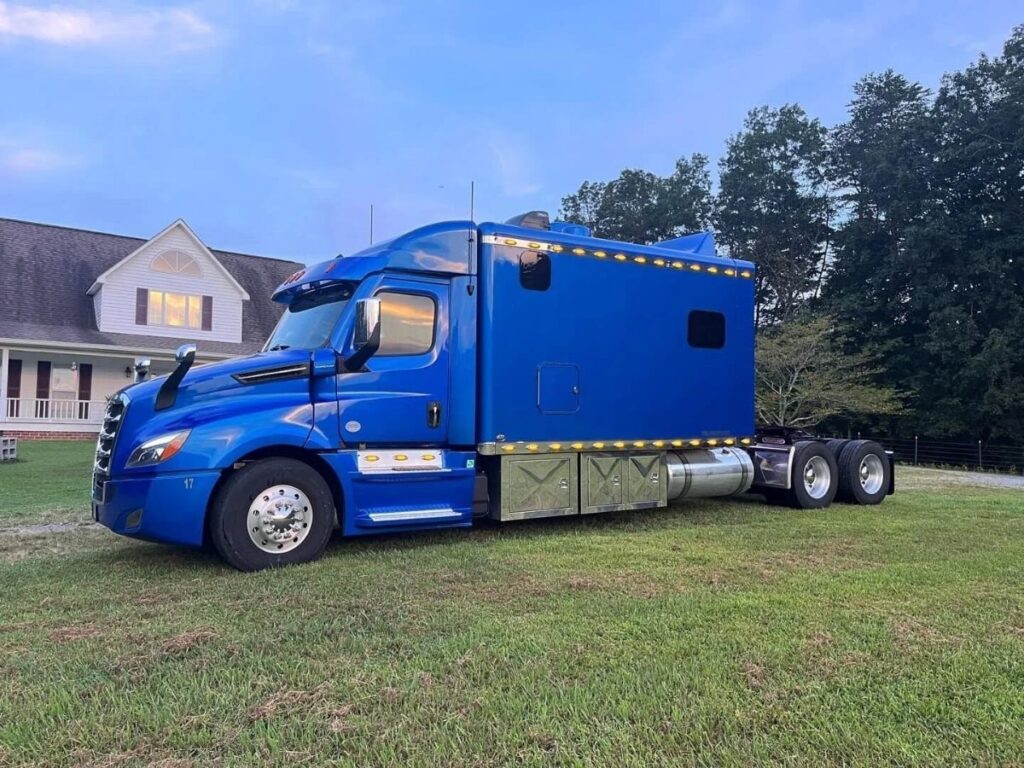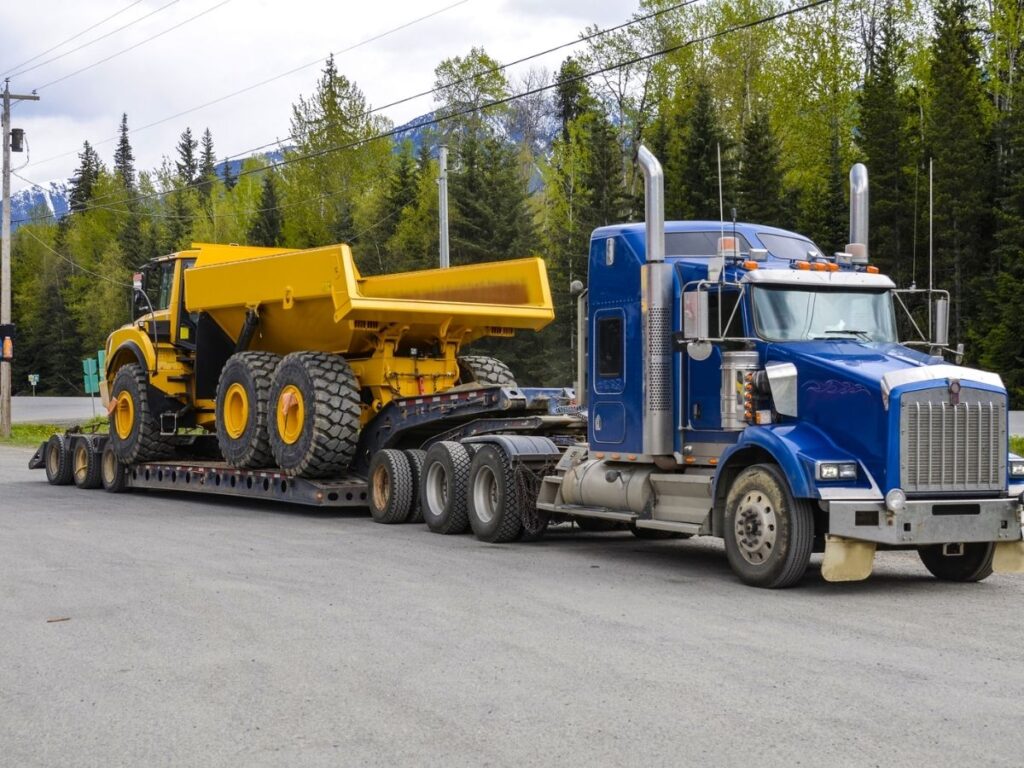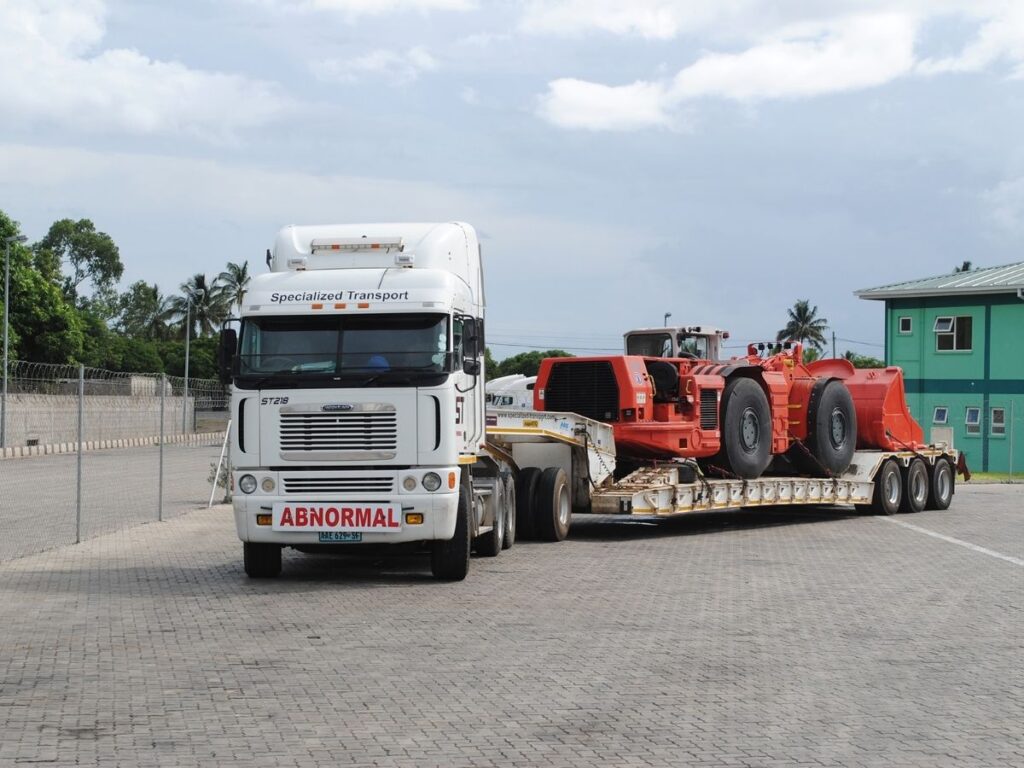“How many gallons does a semi hold?” It’s one of the questions I hear the most—from new drivers, fleet buyers, even folks in construction moving heavy gear.
I got it. Fuel is one of the biggest costs in this business. And if you don’t know how much your truck holds, it’s hard to plan routes or predict expenses.
I’ve been around these trucks for years and working alongside people who live on the road. I’ve listened, learned, and seen what works—and what doesn’t—when it comes to fuel planning.
This article will answer your question clearly. I’ll explain how many gallons most semi trucks hold, why the number changes between setups, and what else you should think about.
By the end, you’ll leave with a clear answer, not a guess.
Let’s get started!
1. Average Gallon Capacity of a Semi Truck
I still remember watching the pump during one of my first fuel stops with a semi truck. I figured it would stop at 80 gallons, maybe 100. But the numbers kept climbing. 120… 140… and still going. That was the moment I realized how different these trucks really are.
If you’re wondering how many gallons a semi truck holds, you’re not alone. It’s something that surprises a lot of people the first time they see it. The size of a truck’s tank can change based on the type of truck, how it’s built, and what it’s meant to haul. Let’s look at the most common setups and their average gallon capacities.
Single Tank Semi Trucks: 120 to 150 Gallons
A large number of semi trucks come with one fuel tank. In most cases, this tank holds between 120 and 150 gallons.
This setup is common on day cabs or short-haul trucks—the kind that travel within one region or stick to a local route. These trucks don’t need as much fuel storage, so one tank is usually enough.
Even with just one tank, these trucks still carry more gallons than a typical vehicle. It’s a simple and space-saving setup that keeps things easier to manage.
If you’re working in city deliveries, construction supply, or local farming transport, this is probably what you’re using.
Dual Tank Semi Trucks: 240 to 300 Gallons Combined
Some semi trucks are built with two tanks—one on each side of the chassis. These are called dual-tank systems.
Each tank usually holds around 120 to 150 gallons, which adds up to a combined capacity of 240 to 300 gallons.
Dual tanks give the truck more range without needing extra space vertically or behind the cab. This setup is helpful for larger rigs that travel long distances or haul heavy loads where more fuel is required between stops.
You’ll often find this setup in sleeper cabs, freight haulers, and long-distance carriers. The extra capacity gives the driver more time on the road and fewer interruptions.
Specialty Tanks: Over 300 Gallons
Not all trucks follow the standard tank sizes. Some are built for jobs that require a much larger fuel reserve—or just more onboard storage. Specialty trucks, such as those used in mining, military, heavy equipment transport, or off-road construction, can hold more than 300 gallons. In some rare setups, capacities can even approach 400 gallons or more.
These tanks are often custom-installed or built into trucks with longer frames. They’re not common on highways, but they’re important for industries where refueling is difficult or the jobsite is far from any station.
If you’re in one of these industries, pairing a high-capacity truck with a purpose-built trailer is key. That’s where companies like Rhinotrail come in—offering custom-engineered semi-trailers for mining, heavy haul, and remote construction jobs. With reinforced chassis, fuel-efficient designs, and region-specific customization, we help maximize every gallon and every haul.

2. Types of Semi Trucks Hold the Most Gallons
Not every semi truck holds the same number of gallons. Some are built for short routes. Others are designed to carry large loads across long distances without needing to refuel often. The difference often comes down to tank setup, chassis size, and the truck’s main job.
During a fleet inspection, I once saw two similar trucks side by side. One had a 150-gallon tank. The other? Two tanks totaling nearly 300 gallons. They were built for different work—and that made all the difference.
If you’re wondering which types of semi trucks typically carry the most gallons, here are three you should know about.
Sleeper Cab Trucks (Up to 300 Gallons)
Sleeper cabs are built for long trips. They have a bed and living space behind the driver’s seat. These trucks are made for cross-country routes where stopping often is not practical.
Most sleeper cabs come with dual tanks, one on each side. Each tank can hold about 120 to 150 gallons, giving a total of 240 to 300 gallons. These are some of the most common high-capacity trucks on the road.
If your job involves long-distance freight, you’re likely driving something similar.

Heavy Haul Trucks (Over 300 Gallons Possible)
Heavy-duty haulers carry large machinery, building materials, or oversize loads. These trucks are built stronger and longer, with more room underneath for larger fuel tanks.
Some of these trucks have custom tank setups that go beyond the typical range. It’s not unusual to see a heavy hauler carrying over 300 gallons, especially when hauling across wide rural areas where fuel stops are few and far between.
This type of truck is common in construction, mining, and large-scale infrastructure jobs.

Specialized Fleet Trucks (Variable, Often 250+ Gallons)
In industries like mining, oil and gas, or military transport, some fleet trucks are built for extreme conditions. They’re not just working on paved roads—they’re out in remote or rugged terrain.
To support these operations, many are fitted with extra-large or custom-designed tanks. These may not always be standard sizes, but they’re made to carry 250 gallons or more, depending on the truck’s frame and application.
These aren’t trucks you see every day, but they’re critical for high-demand industries where fuel access is limited.

3. Factors That Affect How Many Gallons a Semi Truck Holds
I’ve seen trucks that look nearly identical from the outside, but their tank sizes tell a different story. One might carry just 120 gallons, while the other holds close to 300. That’s because gallon capacity isn’t based on looks—it depends on how the truck is built and what it’s used for.
Several factors influence how many gallons a semi truck can carry, and knowing them can help you understand your truck better.
Vehicle Make and Model
Every truck brand comes with its own design standards. Some models are made with smaller tanks for lighter use. Others are built to support dual tanks right from the factory. Even among trucks from the same brand, gallon capacity can differ depending on the model and build year.
Some manufacturers also offer upgrade packages. These might include longer frames, added tank brackets, or larger standard tanks based on how the truck will be used. If your truck was built with custom specs, the gallon range might not match the base model at all.
Intended Operational Use
The job your truck is built for plays a big role in how many gallons it can hold. Long-haul trucks usually carry more gallons because they’re expected to cover more miles without stopping. These trucks are often built with dual tanks to increase range.
In contrast, short-haul or city delivery trucks tend to use smaller tanks. They don’t need to carry as much fuel, and less weight makes stop-and-go driving easier. Trucks built for off-road use may also carry more gallons, since they’re likely to work in remote areas with limited access to refueling. Highway-use trucks usually stick to regulated limits, which can restrict how large their tanks can be.
Weight Distribution and Space Availability
Even if a truck has room for more tanks, it may not be able to carry them legally. That’s because total weight matters. The Gross Vehicle Weight Rating, or GVWR, tells you how much the truck can safely carry—including fuel.
Fuel is heavy. One gallon of diesel weighs around seven pounds. So a tank that holds 250 gallons adds over 1,700 pounds. If the truck is already hauling a heavy load, there might not be enough margin left for bigger tanks. The frame itself also plays a part. A longer chassis can support more equipment, but smaller frames might limit what’s possible.
Fuel Type and Regulatory Requirements
The kind of fuel your truck uses can also affect its tank setup. Most semi trucks run on diesel, but some use alternative fuels like compressed natural gas (CNG) or biodiesel. These fuel systems often require different tank shapes or mounting systems, which can limit how many gallons the truck can carry.
In addition, newer trucks may include emissions equipment like DEF tanks or diesel particulate filters. These take up space under the cab or along the frame—space that might otherwise hold a second fuel tank. In some cases, the cleaner the system, the less room there is for extra capacity.
When it comes to how many gallons your semi truck can hold, it’s not just about the tank itself. It’s about the whole design—from how it’s built, to where it’s going, and what it needs to carry.
4. How to Check How Many Gallons a Semi Truck Holds
Many drivers I’ve worked with didn’t know their truck’s tank size when they started out. And that’s okay. It’s not always obvious. But knowing how many gallons your truck holds can help with everything from refueling to tracking load weight.
Here are a few simple ways to check your truck’s actual tank capacity.
Start with the Tank Label
Most tanks come with a small label or plate that lists the capacity in gallons or liters. It’s often found on the tank’s outer surface.
- Look for a Label or Plate: Check the tank body, especially near the filler cap or welded edges.
- Wipe It Clean if Needed: Dirt and grease can hide the information, so clean it off gently before reading.
- Check Both Sides: If your truck has dual tanks, make sure you read the label on each one.
- Convert if in Liters: If the number is shown in liters, divide it by 3.785 to get the gallon amount.
Look in the Owner’s Manual or Spec Sheet
Truck manuals usually include standard equipment specs, including tank capacity. If the manual’s missing, manufacturer websites often have downloadable sheets.
- Find the Fuel Specs Section: Flip to the technical details or capacities section in the manual.
- Search Online if You Don’t Have the Manual: Look up your truck’s make, model, and year—then find the official brochure or technical page.
- Compare to Your Tank Setup: Some models offer more than one tank option, so check that the info matches what’s physically on your truck.
Use the VIN to Request the Build Info
Your VIN (Vehicle Identification Number) is a 17-digit code that shows exactly how your truck was built at the factory.
- Locate the VIN: It’s usually found on the driver-side dash near the windshield or inside the door frame.
- Call or Email the Dealer: Give them your VIN and ask for the original build sheet.
- Ask About Tank Specs: Request specific details about the tank configuration and size listed at the time of manufacturing.
Estimate by Filling the Tank
If labels are gone and no paperwork is available, this method still works. It’s old-school—but reliable.
- Start from Nearly Empty: The closer to empty you are, the more accurate your reading will be.
- Fill the Tank Completely: Watch the pump until it automatically stops.
- Record the Gallons Pumped: This number will show you the approximate capacity of that tank.
- Repeat for Both Tanks: If you have a dual-tank setup, do the same for the second side and add the totals.
Ask a Mechanic or Fleet Manager
People who work on or manage trucks often know these details off the top of their heads—or they have quick access to them.
- Talk to a Shop Technician: Many mechanics can spot tank sizes by just looking at them.
- Check Maintenance Records: If you’re in a fleet, service logs may already have tank specs listed.
- Bring Your VIN if Needed: If they need to look it up, having the VIN ready makes things faster.
Once you know your truck’s gallon capacity, you can use that number to guide everything from trip planning to tank upgrades.
5. Gallon Capacity Needs by Industry Application
Not all trucks need the same tank size. The number of gallons depends heavily on the type of work being done. Some industries require long-distance hauling. Others run short, local routes where less fuel is needed.
Here’s a closer look at what different industries typically require.
Construction and Heavy Equipment Transport
Construction trucks often move between job sites, sometimes in remote areas or rugged terrain. These jobs involve heavy loads, long idling periods, and tight delivery windows. To avoid frequent stops, trucks in this field often rely on dual tanks with a combined capacity of 250 to 300 gallons. The larger volume supports longer operating hours and greater flexibility on the job.
Mining and Off-Road Operations
Mining trucks work in off-road conditions where fuel stations may be miles away. They operate long shifts and need to stay productive without traveling back and forth for refueling. Many of these trucks are equipped with custom-built tanks that hold over 300 gallons. This high capacity allows them to stay on-site longer and handle rough working conditions.
Logistics and Freight Companies
Freight trucks cover long highway routes and often cross multiple states in one trip. Stopping frequently for fuel slows deliveries and affects scheduling. Most long-haul freight trucks use dual tanks, offering a total of 240 to 300 gallons. This capacity supports extended driving time and helps drivers stay on the move with fewer interruptions.
Manufacturing and Industrial Supply
These trucks typically transport parts, machinery, or materials between factories, plants, and warehouses. Routes are often regional but require reliability and consistency. Depending on distance and load, trucks in this space may use single or dual tanks ranging from 150 to 250 gallons. The goal is to balance capacity with overall vehicle weight.
6. Choosing the Right Gallon Capacity for Your Operation
Selecting the right tank size isn’t guesswork—it’s about aligning the truck with the demands of the job. Many operations run into problems when their trucks carry too little fuel for long routes, or too much for legal weight limits. The right capacity helps improve productivity, reduce downtime, and keep the truck moving.
Here are the key factors to consider when determining the best gallon capacity for a trucking operation.
Route Length
The first step is to assess how far the truck travels during a typical shift. Local delivery trucks working short, urban routes can operate well with smaller tanks. For longer hauls—especially those that cross multiple states or run through remote areas—larger tanks may be necessary. Trucks covering more than 400 miles without reliable stops often benefit from dual tanks.
Load Weight
Fuel adds weight—about seven pounds per gallon. A truck already carrying a near-maximum load may exceed weight limits if tank size isn’t carefully selected. In these cases, a single tank setup may be more appropriate. Balancing fuel capacity with total load weight helps keep the truck compliant with regulations.
Fuel Availability
Fuel station access also plays a role. Trucks that operate in areas with frequent fuel stops can afford to carry less fuel. However, trucks used in rural, off-road, or long-haul applications may need extra capacity to avoid mid-route delays. Availability along the route directly influences how much fuel a truck should carry.
Refueling Downtime
Fuel stops aren’t just about cost—they take time. For time-sensitive operations, fewer stops mean more efficiency. A truck with larger tanks can stay on the road longer, provided the weight and space allow it. This becomes especially useful in logistics and freight transport where delivery timing is critical.
So need a trailer to match your fuel strategy? At Rhinotrail, we build custom semi-trailers engineered for the exact demands of your operation. Our trailers are optimized for load distribution, fuel efficiency, and regional compliance, helping you make the most out of every gallon.
Conclusion
I used to stand at the pump, wondering how much a truck could really hold. Now you know—it depends.
We explored average sizes, what changes gallon capacity, and how to check your own truck. You’re not guessing anymore—you’ve got facts.
So what will you do with that?
Start by applying what you’ve learned. Look at your route, your load, your tank.
And if you’re unsure, don’t go it alone. Rhinotrail specializes in matching the right specs to the right job.
Contact us today to make your setup smarter, not harder.


